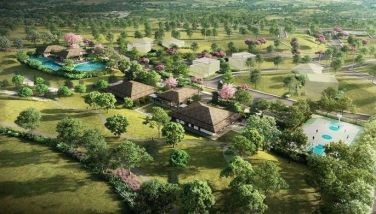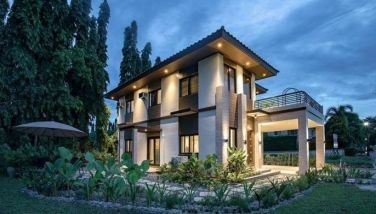Role of urban planning in economic development cited
January 4, 2003 | 12:00am
Architect and urban planner Felino "Jun" Palafox Jr. has underscored the vital role of urban planning in a nation’s social and economic progress.
Palafox spoke on the occasion of the seventh National Real Estate Association (NREA) Conference held at the Kalayaan Hall of the Club Filipino in Greenhills, San Juan, Metro Manila on the theme "Urban Development Well Into the 21st Century."
To expound the theme: he presented three technical papers "Cities in the 21st Century," "Global Trends and Revolutionary Ideas in Urban Development" and the "Urban Futures for our Community Town and Cities."
He emphasized that as we shape our cities, so do our cities shape us and that our responses to the built environment reflect how we perceive our immediate surrounding, as well as our roles as its caretakers.
"Indeed from the environment we live in, there are signposts identifying our cultural identity, including those historical facts and "colonial baggages" to which our cities have been subjected," Palafox said.
He lamented the fact that these "colonial baggages" have brought about problems in urban growth, citing for instance the town plaza concept of the 16th Century Laws of the Indies applied to all Spanish colonies like the Philippines and Latin America.
He said this urban design revolves around a town plaza where the church and the municipal building are situated and where around the plaza are the houses of the principalias and the ilustrados (the elite in the community), and those living far away from de baja de las campanas.
"Such an urban structure indicates the concentration of jobs, trade and commerce within the easy commuting distance for only a small number of people, which unfortunately after more than four centuries the situation has not changed today," Palafox explained.
He pointed out the concentration of jobs and commercial activities at the Makati Central Business District (CBD) and the Ortigas Center, the modern-day town plazas, where these are surrounded by low-density villages.
Palafox maintained that nowhere else in the more progressive cities in the world would you see single-detached single family large homes close to Nathan Road, Hong Kong; Orchard Road, Singapore; Ginza in Tokyo or Fifth Avenue, New York or in the inner cities of Madrid, London and Paris.
Palafox added that we only have this kind of situation only in the Makati CBD and the Ortigas Center, where very low-density residential neighborhoods in large single-family-single-detached house surround the business districts while office workers live two to three hours away from their places of work.
According to Palafox, past surveys have revealed that the Makati CBD has a daytime population 11 times the nighttime population, so the problem is bringing in this huge population in the morning and bringing them out of Makati in the evening.
In contrast, he added that European cities or former British colonies like Hong Kong, Singapore, Boston, Sydney, their town squares were surrounded by higher density townhouses, apartments and shop houses so that there were people living within walking distance to the town centers and large single family homes or mansions were located in the suburbs.
He noted that this urban planning problem was further reinforced with the introduction of cars by the Americans in the 1950s and the rigid zoning during the time segregated the place of work from the place of residence similar to Los Angeles of 1950s/1960s in the Unites States.
This type of planning, he rationalized is widespread in many post-war cities where land uses are segregated through zoning of commercial activities from the residential ones and the mode of transportation is biased to the use of cars, but it was understandable during that time because cars was cheap and so was fuel.
Palafox spoke on the occasion of the seventh National Real Estate Association (NREA) Conference held at the Kalayaan Hall of the Club Filipino in Greenhills, San Juan, Metro Manila on the theme "Urban Development Well Into the 21st Century."
To expound the theme: he presented three technical papers "Cities in the 21st Century," "Global Trends and Revolutionary Ideas in Urban Development" and the "Urban Futures for our Community Town and Cities."
He emphasized that as we shape our cities, so do our cities shape us and that our responses to the built environment reflect how we perceive our immediate surrounding, as well as our roles as its caretakers.
"Indeed from the environment we live in, there are signposts identifying our cultural identity, including those historical facts and "colonial baggages" to which our cities have been subjected," Palafox said.
He lamented the fact that these "colonial baggages" have brought about problems in urban growth, citing for instance the town plaza concept of the 16th Century Laws of the Indies applied to all Spanish colonies like the Philippines and Latin America.
He said this urban design revolves around a town plaza where the church and the municipal building are situated and where around the plaza are the houses of the principalias and the ilustrados (the elite in the community), and those living far away from de baja de las campanas.
"Such an urban structure indicates the concentration of jobs, trade and commerce within the easy commuting distance for only a small number of people, which unfortunately after more than four centuries the situation has not changed today," Palafox explained.
He pointed out the concentration of jobs and commercial activities at the Makati Central Business District (CBD) and the Ortigas Center, the modern-day town plazas, where these are surrounded by low-density villages.
Palafox maintained that nowhere else in the more progressive cities in the world would you see single-detached single family large homes close to Nathan Road, Hong Kong; Orchard Road, Singapore; Ginza in Tokyo or Fifth Avenue, New York or in the inner cities of Madrid, London and Paris.
Palafox added that we only have this kind of situation only in the Makati CBD and the Ortigas Center, where very low-density residential neighborhoods in large single-family-single-detached house surround the business districts while office workers live two to three hours away from their places of work.
According to Palafox, past surveys have revealed that the Makati CBD has a daytime population 11 times the nighttime population, so the problem is bringing in this huge population in the morning and bringing them out of Makati in the evening.
In contrast, he added that European cities or former British colonies like Hong Kong, Singapore, Boston, Sydney, their town squares were surrounded by higher density townhouses, apartments and shop houses so that there were people living within walking distance to the town centers and large single family homes or mansions were located in the suburbs.
He noted that this urban planning problem was further reinforced with the introduction of cars by the Americans in the 1950s and the rigid zoning during the time segregated the place of work from the place of residence similar to Los Angeles of 1950s/1960s in the Unites States.
This type of planning, he rationalized is widespread in many post-war cities where land uses are segregated through zoning of commercial activities from the residential ones and the mode of transportation is biased to the use of cars, but it was understandable during that time because cars was cheap and so was fuel.
BrandSpace Articles
<
>
- Latest
Latest
Latest
October 23, 2024 - 9:30am
By May Dedicatoria | October 23, 2024 - 9:30am
October 11, 2024 - 3:45pm
October 11, 2024 - 3:45pm
October 10, 2024 - 11:30am
October 10, 2024 - 11:30am
October 5, 2024 - 12:08pm
October 5, 2024 - 12:08pm
September 24, 2024 - 1:00pm
September 24, 2024 - 1:00pm
September 13, 2024 - 4:00pm
September 13, 2024 - 4:00pm
Recommended




























